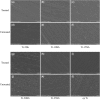Mechanical and biological properties of Ti-(0-25 wt%)Nb alloys for biomedical implants application
- PMID: 32153995
- PMCID: PMC7053259
- DOI: 10.1093/rb/rbz042
Mechanical and biological properties of Ti-(0-25 wt%)Nb alloys for biomedical implants application
Abstract
Binary titanium-niobium (Ti-Nb) alloys have recently been attracted due to low Young's moduli and non-toxic properties. This study explores the influence of low Nb content (0-25 wt%) on the comprehensive parameters of tensile stress-strain relationships (ultimate strength (σUTS), yield strength (σ0.2) and elastic modulus (E)), surfaces properties (Vickers microhardness, surface roughness (R a), water contact angle (WCA), X-ray diffraction (XRD) and scanning electron microscopy (SEM)), corrosion resistance (in artificial saliva and lactic acid) and biological properties (cytotoxicity and alkaline phosphatase activity of MC3T3-E1 pre-osteoblasts) of Ti-xNb alloys (x = 5, 10, 15, 20 and 25 wt%), with using commercially pure grade 2 titanium (cp-Ti) as control. XRD results shown that all the Ti-xNb alloys comprised α + β Ti alloy phases, such that the β phase increased correspondingly with the increased amount of Nb in the alloy, as well as the reduction of E (69-87 GPa). Except Ti-5Nb, all other Ti-xNb alloys showed a significantly higher hardness, increased σUTS and σ0.2, and decreased WCA compared with cp-Ti. No corrosion was detected on Ti-xNb alloys and cp-Ti in artificial saliva and lactic acid solutions. The cytotoxicity of Ti-xNb alloys was comparable to that of cp-Ti in MC3T3-E1 pre-osteoblasts without interference from differentiation behaviour, but the proliferation rate of the Ti-5Nb alloy was lower than other groups. In overall, binary Ti-(10-25 wt%)Nb alloys are promising candidate for orthopaedic and dental implants due to their improved mechanical properties and comparable biological performance, while Ti-5Nb should be used with caution.
Keywords: binary titanium alloys; biocompatibility; biomaterial; low Young’s modulus; titanium–niobium.
© The Author(s) 2019. Published by Oxford University Press.
Figures






Similar articles
-
Effect of Nb on the Microstructure, Mechanical Properties, Corrosion Behavior, and Cytotoxicity of Ti-Nb Alloys.Materials (Basel). 2015 Sep 9;8(9):5986-6003. doi: 10.3390/ma8095287. Materials (Basel). 2015. PMID: 28793546 Free PMC article.
-
Production, microstructural characterization and mechanical properties of as-cast Ti-10Mo-xNb alloys.Artif Organs. 2008 Apr;32(4):299-304. doi: 10.1111/j.1525-1594.2008.00546.x. Artif Organs. 2008. PMID: 18370944
-
Sintering and biocompatibility of blended elemental Ti-xNb alloys.J Mech Behav Biomed Mater. 2020 Apr;104:103691. doi: 10.1016/j.jmbbm.2020.103691. Epub 2020 Feb 10. J Mech Behav Biomed Mater. 2020. PMID: 32174435
-
Biomedical titanium alloys with Young's moduli close to that of cortical bone.Regen Biomater. 2016 Sep;3(3):173-85. doi: 10.1093/rb/rbw016. Epub 2016 Mar 8. Regen Biomater. 2016. PMID: 27252887 Free PMC article. Review.
-
Binary titanium alloys as dental implant materials-a review.Regen Biomater. 2017 Oct;4(5):315-323. doi: 10.1093/rb/rbx027. Epub 2017 Sep 23. Regen Biomater. 2017. PMID: 29026646 Free PMC article. Review.
Cited by
-
Evaluation of Antimicrobial Effect of Air-Polishing Treatments and Their Influence on Human Dental Pulp Stem Cells Seeded on Titanium Disks.Int J Mol Sci. 2021 Jan 16;22(2):865. doi: 10.3390/ijms22020865. Int J Mol Sci. 2021. PMID: 33467097 Free PMC article.
-
Modification of TiAlV Alloys with Hybrid Layers Containing Metallic Nanoparticles Obtained by the Sol-Gel Method: Surface and Structural Properties.Int J Mol Sci. 2022 Feb 18;23(4):2283. doi: 10.3390/ijms23042283. Int J Mol Sci. 2022. PMID: 35216397 Free PMC article.
-
Recent advances in regenerative biomaterials.Regen Biomater. 2022 Dec 5;9:rbac098. doi: 10.1093/rb/rbac098. eCollection 2022. Regen Biomater. 2022. PMID: 36518879 Free PMC article. Review.
-
Influence of processing parameters on dehydrogenation of TiH2 in the preparation of Ti-Nb: A review.Heliyon. 2022 Nov 16;8(11):e11602. doi: 10.1016/j.heliyon.2022.e11602. eCollection 2022 Nov. Heliyon. 2022. PMID: 36439777 Free PMC article. Review.
-
Influence of Bone Definition and Finite Element Parameters in Bone and Dental Implants Stress: A Literature Review.Biology (Basel). 2020 Aug 14;9(8):224. doi: 10.3390/biology9080224. Biology (Basel). 2020. PMID: 32823884 Free PMC article. Review.
References
-
- Eisenbarth E, Velten D, Müller M. et al. Biocompatibility of β-stabilizing elements of titanium alloys. Biomaterials 2004;25:5705–13. - PubMed
-
- Cordeiro JM, Beline T, Ribeiro ALR. et al. Development of binary and ternary titanium alloys for dental implants. Dent Mater 2017;33:1244–57. - PubMed
-
- Iijima D, Yoneyama T, Doi H. et al. Wear properties of Ti and Ti-6Al-7Nb castings for dental prostheses. Biomaterials 2003;24:1519–24. - PubMed
-
- Ponsonnet L, Reybier K, Jaffrezic N. et al. Relationship between surface properties (roughness, wettability) of titanium and titanium alloys and cell behaviour. Mater Sci Eng C 2003;23:551–60.
LinkOut - more resources
Full Text Sources
Miscellaneous

